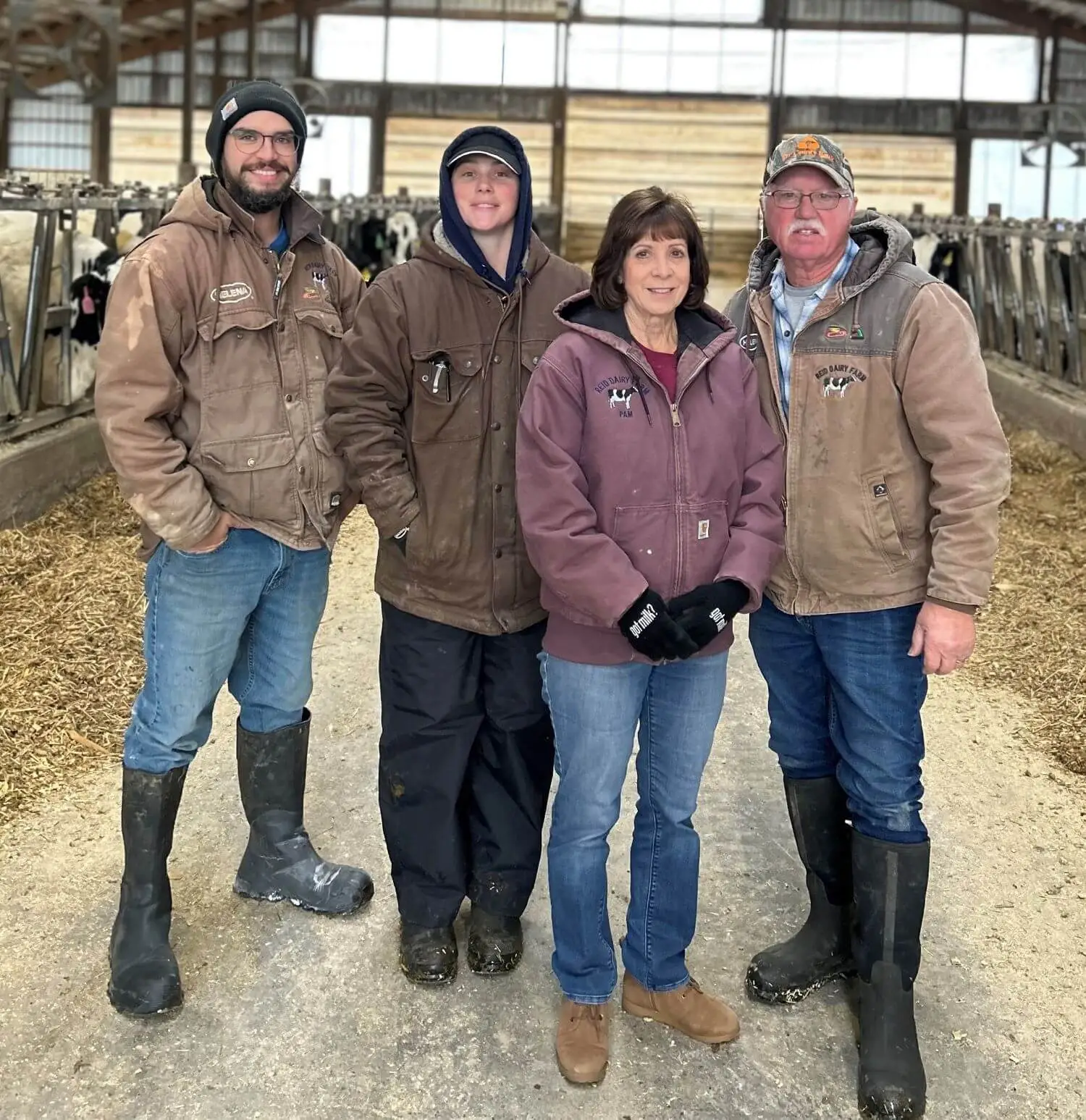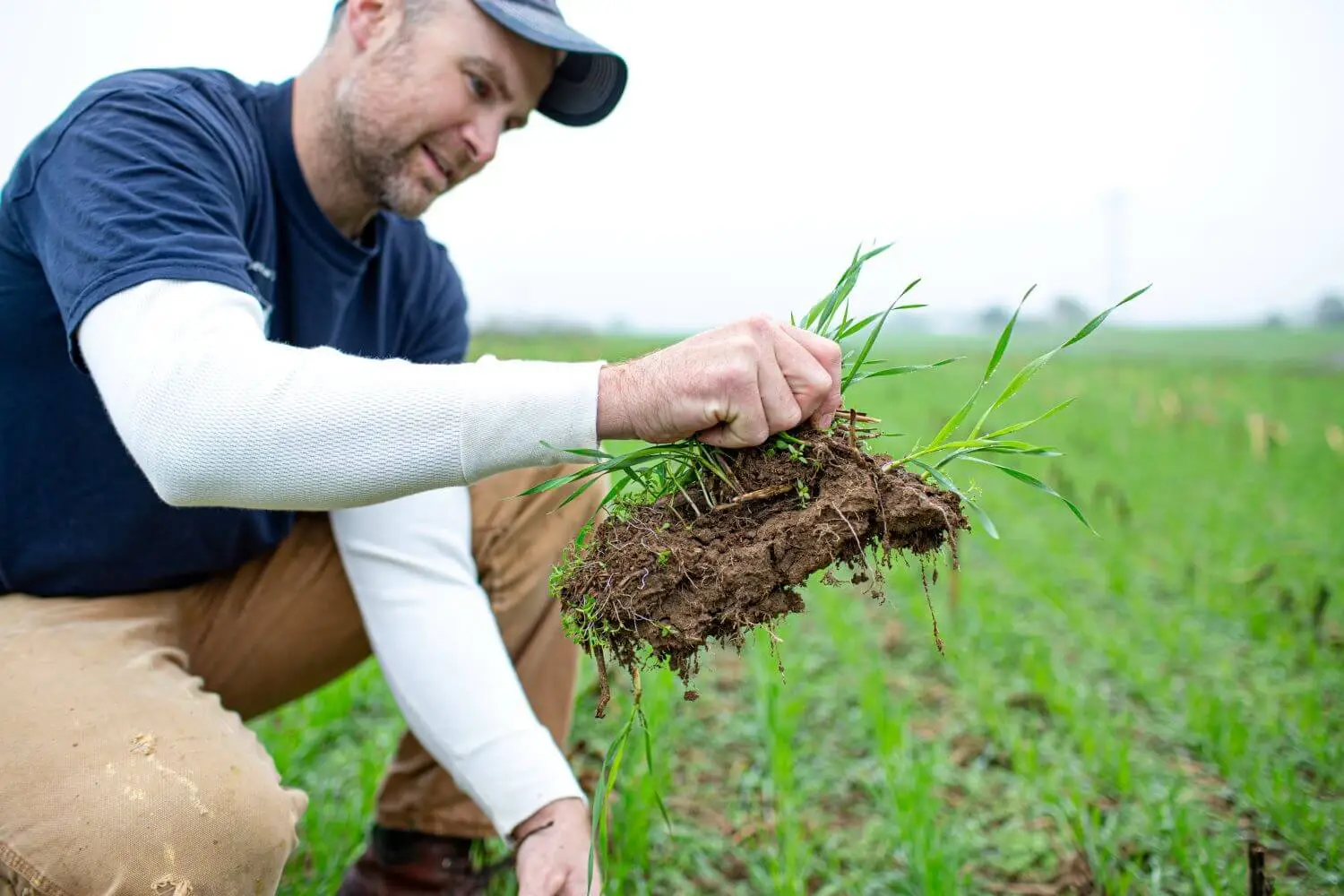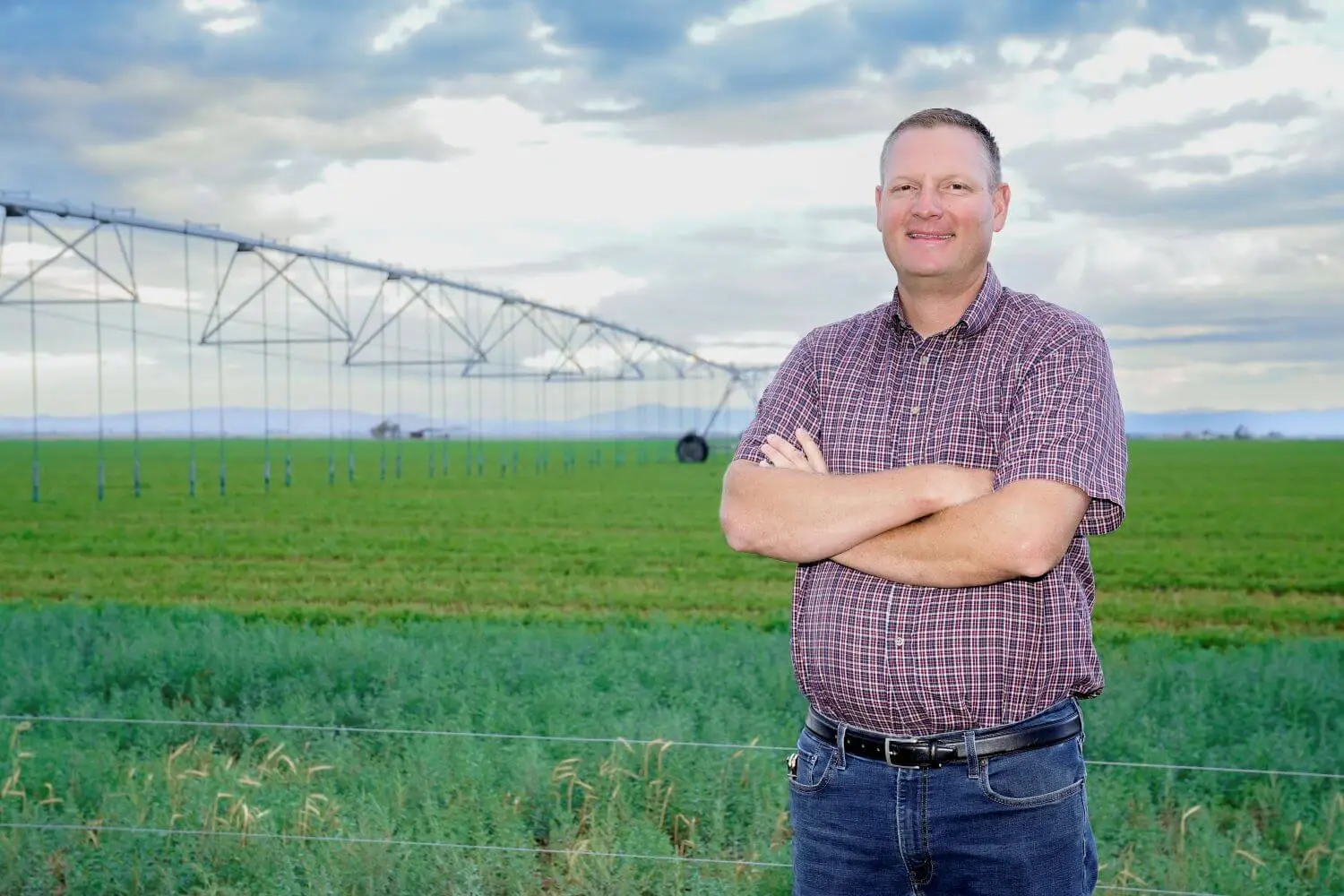How Do Dairy Farmers Reuse Water Responsibly?
If you were to map the path of a single drop of water on a dairy farm, you would see a complex journey – one that’s essential to maintaining cows’ health, and the planet’s. Dairy farmers don't take an ounce of it for granted.
Whether used to clean milking equipment, keep cows hydrated, or grow crops, farmers across the United States work with local communities and researchers to continually maximize their operations’ H2O. That’s more than 26,000 U.S. dairy farm families who innovate to operate. Whether in California or Pennsylvania, most dairies recycle their water as many as four times, including a final stop on the crops.
“How many of us as consumers recycle our water four different ways?” said Lori Captain, executive vice president of global sustainability strategy, science and industry affairs for Dairy Management Inc. “In addition, farmers also are committed to being good neighbors and stewards of their farms. I have visited many farms that are in or near watersheds, and you often find a partnership between the farmer and conservation groups, and they are working together to ensure these waterways are protected.”
Despite a rich history of environmental stewardship, the U.S. dairy industry understands today’s consumers want to see proof from the products and industries they support. Proving a commitment to the Earth and striving for continuous improvement was the inspiration behind the U.S. dairy industry’s 2050 Environmental Stewardship Goals.
- Achieve greenhouse gas neutrality
- Optimize water use while maximizing recycling
- Improve water quality by optimizing utilization of manure and nutrients
Captain says the goals were built following a two-year discovery process, including many interviews with key stakeholders. She isn’t surprised two of the goals focus on water.
“Water is absolutely essential for dairy farmers, just like it is for any of us,” Captain said. “It certainly lives very large in the minds of the dairy industry as we look to improve our environmental footprint.
“Farmers have been environmental stewards for generations, and I think work being done by the research community and through partnerships will build upon what is already a strong foundation. You’ll see dairy farmers take the next step.”
Reducing dairy water use in dry regions
One such step is building the community partnerships that can make the dairy sector part of the solution for water conservation. Brad Scott operates a farm in California, a state that has had its share of water problems thanks to a shortage of rain over the decades.
Scott Brothers Dairy is in the Southern California town of San Jacinto, and there was a time when more groundwater was being pumped than replenished amid population and housing growth. But the dairy struck a win-win deal about 15 years ago with the San Jacinto municipality to accept reclaimed water, or wastewater that can be reused, at their farm.
“We came to the table,” Scott said. “It was a multiple-year process, but instead of me as a farmer using my wells to pump underground water to irrigate my alfalfa, we use 100 percent reclaimed water that we pay for.”
The water travels a couple of miles via underground pipes to Scott’s dairy and other area farms and golf courses. It is treated and free of pathogens.
“What we do on our farm is beneficial to the community,” Scott said. “We’re using reclaimed water that is generated by local households every day. People can still shower and flush and use their appliances that produce wastewater, but farmers can take this water and reduce our need for potable water.”
The Moroneys, a Texas dairy farm family, make the most of every raindrop that hits the barn roof.
The technology to reuse water doesn’t have to be complex. It can be as simple as a well-designed barn roof.
Take the 530,000 total square feet of roofing on the four barns at Del Rio Dairy in Friona, Texas, for example. Rain can be somewhat scarce in this northwest region of the state, with average rainfall just under 18 inches, far less than the national average of 30 inches.
Dairy barn roofs, however, narrow the gap. When rain does fall at the dairy, it runs from the barn roofs and into gutters, similar in concept to what you might have on your home. The difference is this water then heads through pipes and into a lagoon where it is stored to irrigate the farm’s crops that are then fed to its more than 3,000 cows.
Just one inch of rain on the roof translates to about 330,000 gallons of water, the equivalent of 11,000 loads of laundry or 132,000 flushes of a toilet.
“It’s feast or famine around here, so you have to make sure you get it when you can,” said Nathan Moroney, Del Rio Dairy manager. “It seems the drought cycles are lasting longer. We couldn’t exist in our capacity if we weren’t maximizing every single resource.”
Cleaning dairy water near natural waterways
Dairies located near lakes, rivers, and other natural waterways have extra motivation to preserve their integrity. Jim Reid in Michigan is reminded daily of just how important this is. His dairy farm sits high enough that he can see the southernmost tip of Lake Huron four miles away.
He swam in the lake as a kid, and his son Jeff has a boat the family takes out in the summers. Lake Huron has been the site of the Bayview Mackinac Race for sailboat enthusiasts since 1925, and it also is a hotspot for fishermen whose catches of walleye, perch, and coho salmon are featured on local menus.
Reid’s goal is to maintain the serenity of his view and not disturb the lake’s pristine water. He achieves this through on-farm practices designed to prevent runoff. Like many farmers, Reid uses recycled water to clean the barn where manure collects from his 250 cows. Water is flushed over the concrete floor and heads to one of two nearby lined lagoons for temporary storage. One lagoon can hold 1 million gallons, while the other has a 5-million capacity.
Farmers like Reid also use water to sanitize equipment in the parlors where the cows are milked. This water is directed to the lagoons, as is any other water on the farm, thanks to an engineering plan that has the concrete sloped toward the holding areas.
This water features rich nutrient value, thanks to its manure content, and is sprayed as a natural fertilizer on corn and alfalfa crops that are grown to feed Reid’s cows so they can produce milk. This full-circle example is often a part of his conversations with school children and other visitors to his dairy.
“I stand by the lagoon, and I’ll point to Lake Huron and say, ‘These are the things we do to prevent any of this dirty water from ever reaching the lake,’” Reid said. “I take proactive steps that I feel are my responsibility as a citizen of Michigan, and as a good neighbor, to protect the Great Lakes.”
The Reids, a Michigan dairy farm family, are proactive in protecting the Great Lakes.
About an eight-hour drive southeast of Reid is another dairy farmer whose farm resides in a sensitive watershed. Justin Risser of Meadow Vista Dairy in Bainbridge, Pa., has streams that pass through his dairy leading to the Susquehanna River, which ultimately makes its way to the Chesapeake Bay.
“We know the cost of having a dirty Chesapeake,” Risser said. “I think people are blown away at how much we fully understand the grand scope of nature and what we do every day to protect it.”
Risser does his part by keeping things green – literally – at his dairy. His 700 acres of farmland are covered in some sort of vegetation 50 weeks of the year. During the fall, he plants cover crops, which have a fibrous root system that strengthens the soil. This crop, which eventually is harvested in the spring and fed to his 800 cows, prevents erosion during heavy rainfall.
The farm also features buffers, which are undisturbed trees, and vegetation grown near the edges of the streams to slow runoff, offer a filtration process, and prevent soil erosion.
“Nobody likes seeing water running off their fields, but when we do, that’s clear water,” Risser said. “We’ve learned that if you keep things planted, and you keep green vegetation that you will have clean water, and you’ll have a nice filter system to keep the water clear going into the streams.”
Innovative research on dairy water use
Pennsylvania dairy farmer Justin Risser plants crops to strengthen soil, which contributes to water conservation.
Kansas-based McCarty Family Farms is showing how innovative technologies help them meet water-based stewardship goals. The dairy produces about 145,000 gallons of milk each day and has a state-of-the-art milk condensing plant on-site. Every day, milk’s natural water is extracted before it is transported to a dairy processing company. The reclaimed water is used to clean and maintain the processing plant, and as a result, the processing facility is water-neutral. Any additional excess water from this process can be consumed by the cows or used to clean the barns and ultimately used to irrigate the crop land.
In addition, various universities are leading research to help dairy farmers. For example, Kansas State professor Mike Brouk is working with farmers on ways to reduce water that cools cows. Most dairy barns are equipped with overhead sprinklers or misters that dispense water onto the backs of cows with large fans, providing an evaporative cooling process. But Brouk is finding there are water savings to be had without sacrificing cow comfort.
He said many cooling operations run 24-7, even when cows are on other parts of the farm, such as the milking parlor or feed bunk. But systems that only operate when cows are present can lead to reduced water use by up to 70 percent.
“Economics drive a lot of this,” Brouk said. “The more expensive water is, and limited, the better the job we have to do in conserving what we use.”
“Water is a critical topic,” said Reza Afshar, Ph.D., vice president of soil, feed, and water research for Dairy Management Inc. “It is very sensitive from an environmental standpoint, and also farming.”
From a research perspective, Afshar is excited about the Dairy Soil and Water Regeneration project, which started in 2021 to evaluate and assess the impact of advanced soil health management practices on the environmental impacts of dairy forage production. It’s focused on water quality and use, as well as greenhouse gas emissions. Research is taking place on dairies in California, Vermont, Texas, Idaho, Wisconsin and New York.
“We’re looking at how soil management systems affect water quality and reduce runoff and nutrient loss from the fields,” Afshar said. “We hope to obtain verifiable data that can help farmers make informed, science-backed decisions. Dairy farmers want to do their best and maximize the beneficial use of their water, especially in areas where it’s scarce.”
Kimball Holt, a dairy farmer in Utah, plants crops with water conservation in mind.
Utah farmer Kimball Holt has found science-backed ways to conserve water after the farm needed to reduce its aquifer use. One step involved reducing the amount of alfalfa he grew to about half and putting winter wheat into the ground to feed his 5,000 cows. Winter wheat requires less water while producing double the amount of yield per gallon of water.
“Cattle make this possible because they can digest different feeds and it gives us options of what you can produce,” Holt said.
Another key development was the implementation of a Low Energy Precision Application (LEPA) system, which distributes water closer to the ground and below the plant’s canopy to minimize evaporative loss. Between planting winter wheat and LEPA, Holt said the farm has reduced its water use by 15 percent each of the past two years.
And Holt is far from done. He has opened his dairy’s doors to scientists from Utah State, Brigham Young University and Southern Utah University to conduct research.
“Over the last five years we’ve had some sort of research project going on, almost on a constant basis looking at what we’re doing and running trials,” Holt said.
One recent project examined using soil moisture sensors on different parts of his fields that could reduce irrigation frequency. The dairy also uses satellite imagery that identifies portions of crops that are lower in production. This allows Holt to apply fertilizer to the area to bolster growth.
“The best way to save water is to have good yield,” Holt said. “Instead of spreading fertilizer everywhere, we’re targeting specific areas where it’s needed, and we have data proving the rest of the field comes up to that level.”
Afshar, of Dairy Management, Inc., said it’s rewarding to see farmers open to research, knowing it will help lead them on a path to efficient water use and overall environmental stewardship.
“I have never talked with a farmer who doesn’t want to improve,” he said. “Their farms, their businesses depend on water. If you don’t have water, you don’t have forage and if you don’t have forage, you can’t feed your cows and you can’t produce milk. Farmers truly care.”
This care is reinforced through a mission statement Risser has hanging on his office wall in Pennsylvania for all to see. One bullet point emphasizes the importance of being good stewards of the farm’s natural resources.
“We firmly believe that everything we have is not ours and was given to us by God,” Risser said. “When something is given to us, you take good care of it.
“Dairy farming has its challenges. We are an operation that is running 365 days of the year, and weather and seasons come and go, and there are deadlines to meet. But we have a vested responsibility to do our part, and we are doing our best.”



















